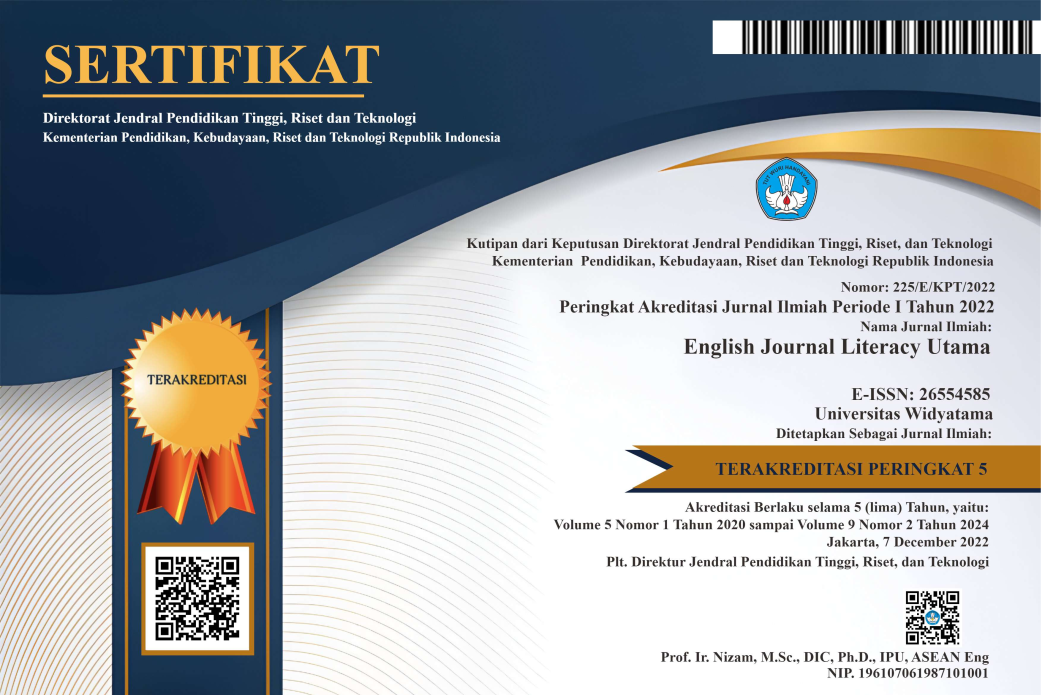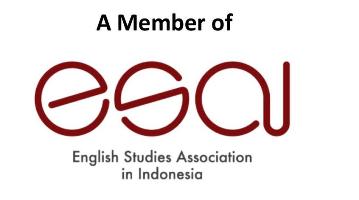EXPLORING THE USE OF ONLINE RESOURCES FOR ENGLISH LANGUAGE LEARNING: STUDENTS' PERSPECTIVES
DOI:
https://doi.org/10.33197/ejlutama.v8i1.231Keywords:
Online resources, English language learning, Students’ perspectivesAbstract
The use of digital technology and the internet has changed how language education works. It gives learners many tools to get better at languages. Teachers and researchers need to understand what online language resources are available to help learners efficiently. This research's main goal is to look into the online resources that students use to learn English and see what students think about them. The data we collected shows that most students like using Language Learning Websites (LLW) to learn English. This shows that interactive websites are important for teaching languages in modern times. The finding that Language Learning Websites are the preferred choice among students aligns with the current trend of a diverse range of LLWs available. Dealing with the students’ perception, the findings shows that the students generally have a positive view of online resources for learning English. However, there are still some challenges to work on to make these online platforms better. Researchers and educators need to keep up with these changes to help language learners in the digital age
References
America, N. (2020). Digital Resources For EL Students. https://www.newamerica.org/education-policy/edcentral/digital-resources-el-students/
André, S., Maulana, R., Helms-Lorenz, M., Telli, S., Chun, S., Fernández-García, C. M., de Jager, T., Irnidayanti, Y., Inda-Caro, M., Lee, O., Safrina, R., Coetzee, T., & Jeon, M. (2020). Student Perceptions in Measuring Teaching Behavior Across Six Countries: A Multi-Group Confirmatory Factor Analysis Approach to Measurement Invariance. Frontiers in Psychology, 11(February), 1–19. https://doi.org/10.3389/fpsyg.2020.00273
Edutopia. (2020). Helpful Online Resources for Teaching ELLs. https://www.edutopia.org/article/helpful-online-resources-teaching-ells
Erbaggio, P., Gopalakrishnan, S., Hobbs, S., & Liu, H. (2012). Enhancing Student Engagement through Online Authentic Materials. 42(2), 27–51. https://doi.org/10.17161/iallt.v42i2.8511
Gray, J. A., & Diloreto, M. (2016). The Effects of Student Engagement , Student Satisfaction , and Perceived Learning in Online Learning Environments. 11(1).
Haleem, A., Javaid, M., Qadri, M. A., & Suman, R. (2022). Understanding the role of digital technologies in education: A review. Sustainable Operations and Computers, 3(February), 275–285. https://doi.org/10.1016/j.susoc.2022.05.004
Hämäläinen, E. K., Kiili, C., Räikkönen, E., & Marttunen, M. (2021). Students’ abilities to evaluate the credibility of online texts: The role of internet-specific epistemic justifications. Journal of Computer Assisted Learning, 37(5), 1409–1422. https://doi.org/10.1111/jcal.12580
Hazari, A. (2014). Learning Curve: student perceptions have a huge impact on understanding. https://www.scmp.com/lifestyle/family-education/article/1407745/learning-curve-student-perceptions-have-huge-impact
Hazaymeh, W. A. (2021). EFL students’ perceptions of online distance learning for enhancing English language learning during Covid-19 Pandemic. International Journal of Instruction, 14(3), 501–518. https://doi.org/10.29333/iji.2021.14329a
Kanellopoulou, C., & Giannakoulopoulos, A. (2021). Internet-Assisted Language Teaching: The Internet as a Tool for Personalised Language Exploration. Creative Education, 12(03), 625–646. https://doi.org/10.4236/ce.2021.123043
Kofo, S. A., Ochayi, O. A., & Jimoh, B. A. (2022). Access and Utilization of Online Learning Resources Among Undergraduate Students. Indonesian Journal Of Educational Research and Review, 5(1), 148–157. https://doi.org/10.23887/ijerr.v5i1.45959
Kuama, S. (2016). Is Online Learning Suitable for All English Language Students? PASAA: Journal of Language Teaching and Learning in Thailand, 52(December), 53–82.
Means, B., Toyama, Y., Murphy, R., Bakia, M., & Jones, K. (2010). Evaluation of Evidence-Based Practices in Online Learning: A Meta-Analysis and Review of Online Learning Studies Center for Technology in Learning. www.ed.gov/about/offices/list/opepd/ppss/reports.html.
Mrah, I. (2022). Digital Media Literacy in the Age of Mis/Disinformation: The Case of Moroccan University Students. Digital Education Review, 41, 176–194. https://doi.org/10.1344/DER.2022.41.176-194
Pecsi, K. (2021). Student Perception of Learning English Online. Central European Journal of Educational Research, 3, 47–55. https://doi.org/10.37441/cejer/2021/3/2/9338
Tinsley, T. (2019). Language Trends 2019: Language Teaching in Primary and Secondary Schools in England: Survey Report. British Council.
Wineburg, S., McGrew, S., Breakstone, J., & Ortega, T. (2016). Evaluating information: The cornerstone of civic online reasoning. Stanford Digital Repository, 29. http://purl.stanford.edu/fv751yt5934
Zhu, Y., Xu, Y., Wang, X., Yan, S., & Zhao, L. (2022). The Selectivity and Suitability of Online Learning Resources as Predictor of the Effects of Self-Efficacy on Teacher Satisfaction During the COVID-19 Lockdown. Frontiers in Psychology, 13(May). https://doi.org/10.3389/fpsyg.2022.765832
Downloads
Published
Issue
Section
License
Copyright (c) 2023 Moh. Choirul Huda, Nugrananda Janattaka, Novan Aditya Prayoga

This work is licensed under a Creative Commons Attribution-NonCommercial-ShareAlike 4.0 International License.
Creative Commons Attribution-ShareAlike 4.0 International License















